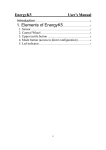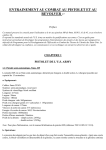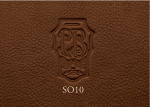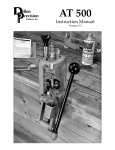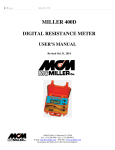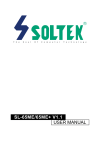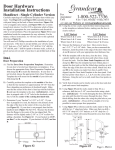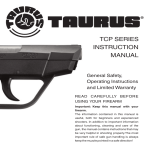Download Charles Daly MS1911-A1
Transcript
1911-Al PISTOL CAL. 45 ACP USER'S MANUAL WARNING: READ THE INSTRUCTIONS and SAFETY PRECAUTIONS IN THIS MANUAL CAREFULLY BEFORE USING THIS FIREARM. TABLE OF CONTENTS Introduction..................................................................................... 2 General Information......................................................................... 2 Basic Model Description....................................................:............... 3 Specification.................................................................................... 3 Safety Features................................................................................ 4 Special Features............................................................................... 5 Ammunition to Use.......................................................................... 5 Operating Instructions » Loading.......................................................................... 6 » Firing............................................................................. 6 » Unloading...................................................................... 7 Basic Disassembly Maintenance » Disassembly..................................................................... 7 » Reassembly...................................................................... 9 Care and Maintenance..................................................................... 10 Parts List.......................................................................................... 10 The Basic Rules of Safe Firearms Handing........................................... 12 Warranty Information........................................................................ 13 Exploded Drawing.......................................................................... 14 Introduction As a responsible firearms owner, you must read this USER'S MANUAL thoroughly and become familiar with if before you handle your new CHARLES DALY PISTOL. This USER'S MANUAL is designed to assist you in learning the proper use and care of your handgun. After reading this manual, examine your handgun carefully and make sure you understand all of the basic features associated with it. This includes knowing its basic parts, how the safety features operate, how to open and close the action and how to safety load and unload ammunition. Remember that improper use and handling of this handgun is dangerous, may void the warranty and could cause severe injury or death to you personally or those around you. The CHARLES DALY PISTOL is as well made as modern technology allows and will give you a lifetime of reliable service, security and pride of ownership. You, the owner, must use it properly and take good care of it, as per the instruction given in this USER'S MANUAL and must not hesitate to ask pertinent questions from the manufacturer or from competent gunsmiths. This USER'S MANUAL should always be kept available for reference and should accompany the firearm if transferees to another party. GENERAL INFORMATION The Colt Government Model 1911-AI semi-automatic pistol, designed by John M. Browning, has been one of the world's most popular side arms. It is a tried and proven design which outlasted its contemporaries and is still the top firearm choice for military, police and competition shooters throughout the world. Because of its practical design, safety features and rugged construction, it has been considered by many military experts as the best close range defense weapon ever designed. BASIC MODEL DESCRIPTION The CHARLES DALY PISTOL in Cal. 45 ACP, is designed for both combat and competition, combines the best accepted principles of strength, safety, accuracy, mechanical reliability and ease of handing-all to meet the most exacting standards of law enforcement, military, self defense and competition shooting. All parts are made of high grade ordnance steel and heat treated for strength and durability. The lug contact areas being the locking elements of the frame, slide and barrel, are precisely machined and heat treated, providing accuracy, toughness and rigidity in the locked firing position. The frame, slide and other action parts are made by precision investment casting and CNC-machined to equally consistent dimensions to ensure mechanical efficiency; long life and complete parts interchangeability. SPECIFICATIONS Model Caliber Action 1911-A1 .45 ACP Semi-Auto, Recoil Operated Magazine Cap Effective Range Overall Width Overall Length Overall Height Weight, Empty Weight, Loaded Trigger Pull Barrel Length Sights, Front Rear 8 Rounds 50 Meters 33 Mm. 213 Mm. 138 Mm. 1.11 Kg. 1.29 Kg. 1.81 to 2.95 Kg. 125 Mm. Fixed Driven in Dovetail Cut Rifling Twist Right hand. One Turn / 400 Mm. No. of Grooves 6 Finish Blued NOTE: Specifications subject to change without prior notice. SAFETY FEATURES WARNING: THE USER SHOULD NEVER DEPEND ON SAFETY MECHANISM OR ANY OTHER MECHANICAL DEVICE TO JUSTIFY CARELESS AND IMPROPER HANDLING. 1. Safety Lock: The pistol is fitted with a safety lock which when applied at the cocked position, blocks the sear and hammer to prevent the gun from being fired. 2. Grip Safety: The pistol cannot be fired until the grip safety is pressed in, when the gun is gripped for firing. 3. Disconnector Safety: The pistol is designed with an automatic disconnector which enable it to fire only when it is fully locked and the trigger is released after each shot. 4. Half-cocked Position: The hammer is provided with a half cock notch which allows it to be locked in the half-cocked position in cases of unintentional hammer release or follow through caused by sear bounce. 5. Inertia Firing Pin: The firing pin is designed to operate on the principle of inertia, with its length shorter than the overall length of the breech block. It requires a blow from the fully cocked hammer to strike and percuss the cartridge primer. SPECIAL FEATURES • Double slide serrations cut for optimal grip and cocking ease. • Lowered side ejection port for a more efficient and reliable ejection of Spent shells. • Skeletonized combat hammer with serrated non-slip thumb surface and matching large oval opening for light weight and reduced lock time. • Beavertail grip safety which protects the hand from non-slip thumb surface and matching large oval opening for light weight and reduced lock time. • Extended slide stop that gives better leverage for lighter and faster slide release. • Extended ejector the flips fired cases clear of the slide to help prevent "smoke stacking" and jams. • Wide extended ambidextrous safety designed for the natural sweeping motion of the thumb for fast, reliable and comfortable operation. It is ideal for the "thumb high" hold for both right-handed and left-handed shooters. • Non-slip serrated and skeletonized trigger. • Specially designed checkered high-impact phenolic grip. • Plastic carrying guncase with eggcrate-type poly-foam for ultimate gun protection. • Two (2) magazines per gun. Note: Specifications and features subject to change without prior notice. AMMUNITION TO USE The CHARLES DALY PISTOL is chambered for cat. 45 ACP cartridge in the round nose configuration (Note: Use of wadcutter may require extra adjustment of the barrel feed ramp by a competent gunsmith), manufactured in the accordance with industry standard. Non-standard or improperly loaded cartridges affect accuracy and cause mechanical feeding problem. Always check for the following possible defects before loading the ammunition into your pistol. a. poorly seated primers. b. incorrect seating length c. lead deformation on the front and shoulder d. over expanded case mouth e. improper crimping f. damaged case rims CAUTION: NEVER USE CARTRIDGES OF UNKNOWN CALIBER, ORIGINAL AND LOAD. IT IS EXTREME1Y DANGEROUS TO USE A CARTRIDGE WHOSE PRESSURE IS GREATER THAN INDUSTRY STANDARDS, AS THE FIREARM MAYBE DAMAGED, AND DEATH OR SERIOUS INJURY TO THE SHOOTER OR OTHER PERSONS MAY RESULT. OPERATING INSTRUCTION WARNING: ALWAYS KEEP THE PISTOL POINTED IN A SAFE DIRECTION WHEN LOADING AND UNLOADING. INSPECT THE CHAMBER AND BORE OF THE BARREL FOR ANY OBSTRUCTION, EXCESSIVE OIL OR GREASE. FAILURE TO DO SO MAY RESULT IN GUN DAMAGE AND/ OR INJURY TO THE SHOOTER OR THOSE NEARBY. LOADING To load the magazine, place the first cartridge in the front end of the magazine follower and push it down until it can be slid in under the feed lips of the magazine. Place the second cartridge on the top of the first and force it down in the same way as the first one. Repeat this procedure until the magazine contains the number of cartridges you intend to load. The magazine can take as many as eight (8) rounds. To load the pistol, insert the loaded magazine into the grip (handle} and push it up until the magazine release engages in its slot locking in place. Hold the pistol firmly with your firing hand. Grasp the slide at its serrated section with your other hand and pull it to the rear as far as it will go. (Note: the hammer can be cocked first to make the slide easier to pull). Then, release the slide smartly. A cartridge is now loaded in the chamber and the pistol is ready to fire. Push the safety lock upwards into the "SAFE" position and leave it there until ready to shoot. FIRING To fire the pistol, press the safety lock down to the "FIRE" position. Obtain the correct sight alignment and sight picture and squeeze the trigger. To fire successive shots, the trigger must be released and squeezed repeatedly. When the last cartridge from the magazine has been fired, the slide remains to the rear. If you intend not to shoot or cease firing, remember you have a loaded gun in your hand. First keep the gun pointed in a safe direction and keep your finger off the trigger. Then, unload the gun by following the unloading procedure below. UNLOADING To unload, press the magazine release and remove the magazine. If the slide is in the forward position, pull it to the rear and retain by pushing the slide stop up. Inspect the chamber to make sure that the pistol is clear and unloaded. If the chamber is empty, press the slide stop down while squeezing the trigger, allowing the slide to go forward. If there is a shell or unfired cartridge in the chamber, manually remove it before pressing the slide stop down. Your gun is now unloaded. BASIC DISASSEMBLY AND REASSEMBLY Disassembly Barrel and Slide Assembly: 1. Press the magazine release and withdraw the magazine. Pull the slide backwards and check the chamber to ensure that the pistol is unloaded and safe. 2. Press the recoil spring with your thumb and rotate the barrel bushing clockwise. 3. Gently allow the plug and recoil spring set to move forward. Do not remove the set as this will keep the recoil spring guide in place. 4. Pull the slide backwards until the smallest slot on its left aligns with the top rear of the slide stop. Remove the slide stop by pressing its pivot stud on the right side of the frame. 5. Pull the slide directly forward of its guide rails in the frame. The barrel, barrel bushing, recoil spring, recoil spring guide and recoil spring plug will come out with it. 6. Remove the recoil spring, guide and plug from the slide. 7. Rotate the barrel bushing to the left as far as it will go and withdraw it to the front. 8. Tilt the barrel link forward to withdraw the barrel through the front of the slide. 9. Remove the firing pin by pressing it with & pin while simultaneously pushing the firing pin stop downwards and out of the slide. 10. Using a pin (or the firing pin itself), pry the extractor by its groove out of the slide. B. FRAME ASSEMBLY 1. Remove the pair of grip panels by unscrewing the grip screws with a screw driver of the correct size. 2. Cock the hammer. Hold the thumbpiece of the safety firmly with your thumb and index finger and exert a steady pressure to pull it outward while twisting it back and forth. The safety lock will thus come out of the frame. 3. Lower the hammer by gripping the frame as if for shooting, to compress the grip safety and press the trigger: while ho/ding onto the hammer to ease it down. 4. With the pivot stud of the safety lock, force the hammer pin out of the frame. This will permit the hammer and the hammer strut attached to it to be lifted out. 5. With the end of the hammer strut or a suitable punch, push the main spring housing pin out of the right side of the frame. 6. Withdraw the main spring housing assembly straight down out of its grooves in the frame. 7. Remove the grip safety and the three-leafted sear spring rearward from the frame. 8. Again, using the hammer strut, push the sear pin from right to left removing it out of the frame. This will permit the sear and the disconnector, which are both mounted on this pin, to be withdraw, out of the frame. 9. Partly push the magazine release in on the left side of the frame by as much as .075 in., and rotate the magazine release lock a quarter turn form right to left with a small screw driver. This enables the magazine release assembly to be removed out of the frame as a unit. 10. Remove the trigger assembly out of its recess cuts in the frame. / /. Push the combination slide and safety lock plungers and the spring between them out to the rear of plunger tube. 12. Drift the ejector pin and lift the ejector out of its seat in the rear of the frame. 13. To dismantle the main spring housing assembly, force the main spring cap down with a punch and push the main spring cap pin put of its hole in the main spring housing. This will permit the main spring cap, the main spring, and the spring housing pin retainer to be withdrawn from the housing. REASSEMBLY While reassembly of the dismantled pistol is done in the reverse order of disassembly, the following special instruction will be of assistance: 1. When the barrel and slide assembly is to be mounted on the frame, hold both the slide and the frame bottom side up. Make sure that the barrel link is tilted to the front as far as it will go and that the barrel link pi is flush in its seat. Then slide the frame forward into the slide rails. 2. The disconnector and sear are assembled together and it is important that they be in proper position. To do this, first mount the sear over the disconnector (curved section inward, lugs pointing downward}. Put the parts together into the frame by inserting the rounded head of the disconnector in its hole in the frame so that the flat face of its lower end rests against the trigger stirrup. Slightly press the trigger so that the holes of the two parts will line up with that of the frame. Holding them this way, insert the sear pin from the left side of the frame making sure that it passes through both the disconnector and the sear. 3. In replacing the sear, make sure that its lower end is caught in the slot located at the bottom rear of the frame handle. The upper end of the left-hand leaf must rest against the sear. While retaining in this position, slide the main spring housing up in its grooves until its end is projecting only about one-eight of an inch below the edge of the bottom of the frame. 4. Cock the hammer to replace the safety lock. 5. Having replace the hammer, the grip safety and the safety lock, cock the hammer. Make sure that the hammer struts rests on the main spring cap. Then, push the main spring housing up into the frame to its final position and retain the assembly by driving in the main spring housing pin. CARE AND MAINTENANCE With proper care, your CHARLES DALY PISTOL will provide you with years of dependable service. It should be inspected, cleaned and oiled periodically to ensure that it remains in good condition and functions safety and reliability. Doing the job requires no total disassembly of the mechanical parts in the frame assembly. Under normal cleaning purposes, field stripping or dismounting of the slide and barrel assembly is sufficient. To clean the pistol after firing, first dismount the slide and barrel assembly. Scrub the barrel bore and chamber with a bore brush dipped in a gun cleaning solvent to remove lead residues and foreign matters left inside. Using an old toothbrush dipped in solvent, clean the areas around the slide's breech face to remove powder and primer residues. Other parts and areas to be cleaned are the slide and barrel locking lugs, the frame and slide rails, firing pin, extractor claw and other adjacent areas. After cleaning, wipe all surfaces with a clean dry cloth to remove all traces of the solvent and apply a light film of oil immediately thereafter. To clean the pistol thoroughly, disassemble all parts to the extent described above, taking care not to ruin or lose any part. Clean and inspect all parts then dry and lubricate very lightly. Reassemble the pistol, dry the barrel chamber and bore and check the gun for proper functioning before loading live ammunition. When storing the gun for a prolonged period of time, it is necessary to oil it heavily with an acid-free lubricant. The external must be coated with an antirust oil or grease to prevent moisture from settling on the metals and sipping into the internal mechanism causing the parts to rust and malfunction. Before usage, the pistol must be cleaned and wiped dry again as discussed above. CAUTION: THE GUN SHOULD BE STORED IN ROOMS WITH DRY ATMOSPHERE AND WITH THE LEAST HUMIDITY. IT SHOULD NOT BE STORED ENCASED IN LEATHER OR ANYTHING THAT WILL ATTRACT AND HOLD MOISTURE, CAUSING THE METAL PARTS TO RUST. Parts List (Note: With Reference to the Exploded, Drawing on page 14) Part No. Description 4501 Barrel 4502 Barrel Bushing 4503 Barrel Link 4504 Barrel Link Pin 4505 Slide 4506 Slide Stop 4507 Slide Stop Plunger 4508 Plunger Spring 4509 Firing Pin 4510 Firing Pin Spring 4511 Firing Pin Stop 4512 Extractor 4513 Front Sight 4514 Rear Sight 4515 Recoil Spring 4516 Recoil Spring Plug 4517 Recoil Spring Guide 4518 Frame 4518PT Plunger Tube 4519S Magazine Box 4520S Magazine Spring 4521S Magazine Follower 4522S Magazine Spring Plate 4523S Magazine Base Pad 4524 Magazine Release 4525 Magazine Release Lock 4526 Magazine Release Spring 4527 Grip Panel Right 4528 Grip Panel Left 4529S Grip Screw 4529GSP Grip Screw Bushing 4530 Trigger Shoe 4531 Trigger Stirrup 4532 Trigger Stirrup Pin 4533 Hammer 4534 Hammer Pin 4535 Hammer Strut 4536 Hammer Strut Pin 4537 Sear 4538 Sear Pin 4539 Sear Spring 4540 Disconnector 4541ASL Ambi Safety Left 4541ASL Ambi Safety Right 4542 Safety Lock Plunger 4543 Ejector 4544 Ejector Pin 4545 Grip Safety 4546 Main Spring 4547 Main Spring Cap 4548 Main Spring Cap Pin 4549 Main Spring Housing 4550 Main Spring Housing Pin 4551 Main Spring Housing pin Retainer BASIC RULES OF SAFE FIREARMS HANDLING Safety must be the first and constant consideration of every person who handles firearms and ammunition. A person with a gun in his possession has an important responsibility. He must know how to use his firearm in a way which will ensure his own safety and that of others. Firearms do not cause accidents! Firearms accidents are almost a/ways found to have been the result of carelessness, or ignorance on the basic rules of safe gun handling on the part of the users. The following rules must be strictly observed by gun users at all times: 1. Always keep the gun holstered except when drawn for a definite purpose. 2. A/ways check the gun for live ammunition when picked-up, drawn from the holster, handed to or received from another person. 3. Never point the gun at anything you don't intend to shoot. 4. Never load and lock the gun unless you are ready to shoot. Do not even insert your finger in the trigger guard until you are ready to shoot. 5. Avoid dry-firing even with dummy cartridges, unless same is performed on a regular target range or at a known inanimate target. 6. When holding the gun that is ready to fire, be absolutely certain that it is not pointed at any pan of your body nor at any person within your immediate vicinity. 7. Beware of obstruction in the barrel. If, when firing, a weak or peculiar report is heard, cease firing, unload the pistol and inspect the barrel for an obstruction. A struck bullet or any other object on the barrel should be removed immediately. Not doing so may result in a bulged or burst barrel which may cause injury to the shooter or bystanders. 8. When a misfire is experienced, keep the gun pointed at the target for at least ten seconds before inspecting it; a delayed firing may occur. 9. As much as possible, wear shooting glasses and hearing protectors when firing. 10. Do not shoot at a hard surface or water for the bullet can glance off and travel in unpredictable directions with considerable velocity. / /. Avoid drinking alcoholic beverages and/or taking prohibited drugs when handling the firearm. STATEMENT OF LIABILITY The CHARLES DALY PISTOL is classified as a firearm of dangerous weapon. It is expressly understood that the manufacturer of CHARLES DALY assumes no liability for its resale or unsafe handling under local laws and regulations: and for physical injury or property damage resulting from either intentional or accidental discharge, or for the function of the gun subjected to influence beyond the manufacturer's control. CHARLES DALY will honor no claims which may result from careless handling unauthorized adjustment, defective or improper ammunition, corrosion or neglect. WARRANTY CHARLES DALY will adjust or repair, to its commercial standards, the firearms or any part thereof found to be defective in material or workmanship. Such services shall be made free of charge within one (1) year from date of registered purchase. Charles Daly MODEL MS Charles Daly now introduces the new downsized Model MS 1911-A1 pistol in caliber 45 ACP. It is basically a shortened version of the original full-size (Model FS) Charles Daly M1911-A1. The overall length of the MS pistol is one inch shorter but with the same grip length giving the same firepower and good handling characteristics as with the full size parent. Most features present in the standard version are available in this new model including the ambidextrous safety, skeletonized trigger and combat hammer, beavertail grip safety, squared slide serration lowered ejection port and beveled magazine well. Added features include the extended ejector, use of a reverse recoil spring plug and a full length recoil spring guide which acts as a stabilizer. Dovetail front and rear sights are standard on all Charles Daly 1911- A1 pistols. The MS uses the same internal parts of the full size model except for a shortened barrel bushing and standard slide stop. Disassembly of the MS pistol is done by first removing the slide stop and separating the slide-barrel-recoil spring assembly from the frame. The recoil spring guide is then pushed forward compressing the recoil spring until the small hole on it comes out of the reverse recoil spring plug. A paper clip with 5/16 inch of its end bent at 90 degree angle (Fig.1 on back page) is inserted into the hole trapping +he spring assembly (Fig.2). At this point, the recoil spring guide assembly can now be pulled out rearward of the spring tunnel (Fig.3). No further disassembly is recommended for routine cleaning and maintenance purposes. MODEL MS 1911-Al



















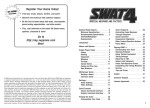
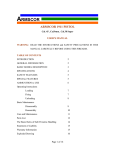
![Analógico - Digital Trainer [MODELO - XPO – ANADIGI]](http://vs1.manualzilla.com/store/data/006173207_1-f6919e7236563b4270311c3a336f3778-150x150.png)


